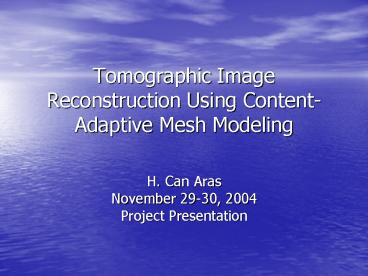Tomographic Image Reconstruction Using Content-Adaptive Mesh Modeling - PowerPoint PPT Presentation
1 / 22
Title:
Tomographic Image Reconstruction Using Content-Adaptive Mesh Modeling
Description:
Second derivative used, below is the theoretical basis for this. M2 : the least upper bound on the second ... Time problem can be overcome by precalculation. ... – PowerPoint PPT presentation
Number of Views:52
Avg rating:3.0/5.0
Title: Tomographic Image Reconstruction Using Content-Adaptive Mesh Modeling
1
Tomographic Image Reconstruction Using
Content-Adaptive Mesh Modeling
- H. Can Aras
- November 29-30, 2004
- Project Presentation
2
Problem Approach
- Reconstruction
- of
- CT-Images
- from
- Projection Data
- Content-Adaptive Mesh Generation
- Estimation of Mesh Nodal Values
- Reconstruction of the Image by Interpolation
3
Phantom Reference Image
4
Feature Map Extraction
- Second derivative used, below is the theoretical
basis for this. - M2 the least upper bound on the second
directional derivative of f(x) over T - h the length of the longest side of T
- The formula tells us two things
5
Feature Map Extraction (cont.)
- To achieve a low approximation error of the
image - Small elements in large second derivative regions
- Relatively larger elements in relatively small
derivative regions
6
Feature Map Extraction (cont.)
- Not practical to calculate directional
derivatives - Use max ( fxx , fxy , fyy ) or the
magnitude of the second derivative - Normalization of feature map
- Segmentation of heart and background region
- Modification of feature map
7
Result
8
Placement of Mesh Nodes
- Floyd-Steinberg error-diffusion algorithm
- Originally designed for digital halftoning
- The objective is to use the spatial density of
the ink dots to represent the image intensity. - The classical method used varying ink dot sizes.
9
Placement of Mesh Nodes (cont)
- Distribute errors among pixels
- Uses the perception characteristics of the human
eye - Fast, efficient and produces excellent results
(almost)
10
Result
11
Connecting Mesh Nodes
- Delaunay triangulation
- Returns set of triangles such that no data point
is contained in any triangles circumcircle - Known to yield a well-structured mesh
- Avoids producing excessively elongated elements,
reducing the error bound
12
Result
13
Estimation of Mesh Nodal Values
14
Reconstruction of Image
- Pixel value is approximated from the nodal values
of its enclosing triangle - Master element
- Shape functions
15
Result
16
Numerical Comparison
- PSNR of FBP result 47.51
- PSNR of MESH-ML result 46.77
- compression rate 5.36
- Note A higher PSNR does not always correlate
well with the perceived image quality (although
it provides a measure for relative quality) - A slight change on MESH-ML result gives higher
PSNR. - Subtracting only 0.01 from each value of MESH-ML
result yields a PSNR of 48.81. Subtracting 0.02
yields 51.05! - The authors may be using another trick for PSNR!
17
A Comment on Results
- The mesh nodal values tend to increase slightly
on average after MESH-ML. - Until a number of iterations, the results get
better. Behind this limit, results tend to go
bad, even worse than FBP (reference) image.
18
Problems Faced
- Radon Transform followed by Inverse Radon
Transform yielded an image with negative values
because of incomplete set of projections. - I adjusted this image between 0,1 so that the
initial values of the mesh nodes are not negative
in MESH-ML algorithm.
19
Problems Faced (cont.)
- Delaunay Triangulation is sensitive to the
position of the nodes. - Degenerate cases occur frequently when using
integers for position coordinates. - I randomly changed the position coordinates with
very small differences and used double instead of
integer.
20
Problems Faced (cont.)
- The analytical form of the response function is
not known. - Hence, I calculated the system matrix by probing
the input with an impulse function as offered in
the paper. - Specifically, a unit-impulse was applied at each
nodal location of the mesh model, and the
response at each detector was computed. - This computation is time and memory consuming.
- Time problem can be overcome by precalculation.
- I used sparse matrix since most of the system
matrix is zeros. - The MESH-ML algorithm takes longer than expected.
21
Plan
- Try to make MESH-ML algorithm faster (not the
main concern, but can be a bottle-neck for the
tests below). - Run MESH-ML with multiple iterations.
- Use better reference image in terms of the number
of projection angles (5 degrees used between
consecutive projections in the experiments). - Use better reference image in terms of the filter
used in Fourier domain (Ram-Lak ramp filter used
in the experiments). - Test on medical images, which capture different
parts of the body.
22
Thank you for listening
- Wish me more luck!































